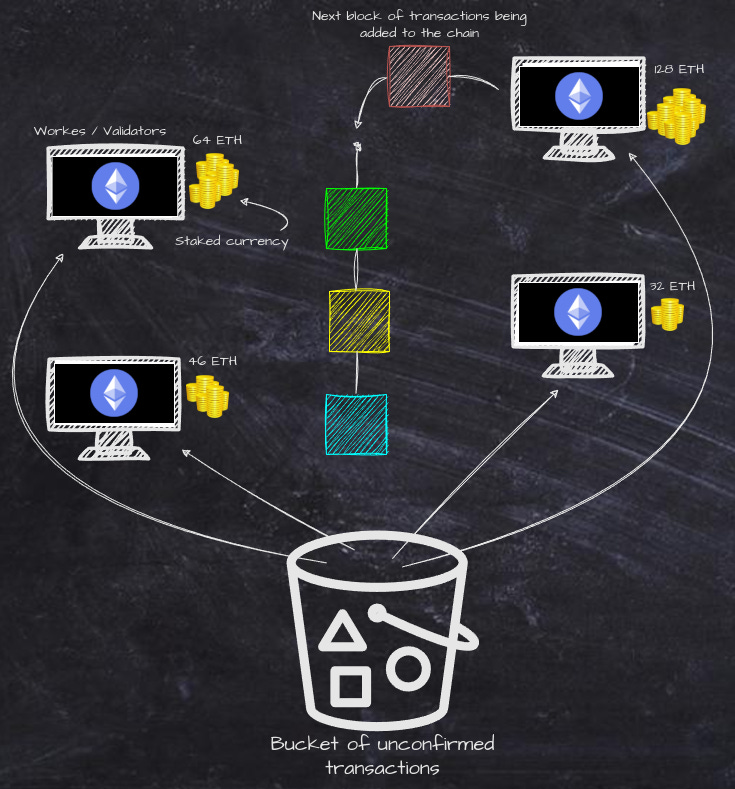Monday 21st July 2025

It was a while ago since I wrote part 1 about bitcoin and gold. With CBDCs closing in, I thought it was about time to write a part 2. Spoiler alert if you haven’t read part 1: I’m not convinced that Bitcoin is even near the perfect decentralized economic system, so the quest goes on.
Short summary about the inventor
In contrast to the inventor of bitcoin, the inventor of Ethereum has a real name and a wikipedia article.
Ethereum was invented by Vitalik Buterin. Born 1994 in Russia but his family emigrated to Canada when he was 6 years old. His father was a computer scientist, which must have had some influence on him. He dropped out of university to work full time on Ethereum, but still received an honourary doctrate in Business and Economics by the University of Basel, Switzerland, when he was mere 24 years old. He basically is a genious.
The Economics of Ethereum
Ethereums native token ETH is currently rated as the 2nd most valued crypto token on the market, next to Bitcoin. Why is it still so highly ranked? Let’s dig deeper into the protocol to see where the value comes from.
Historical graph of ETH value
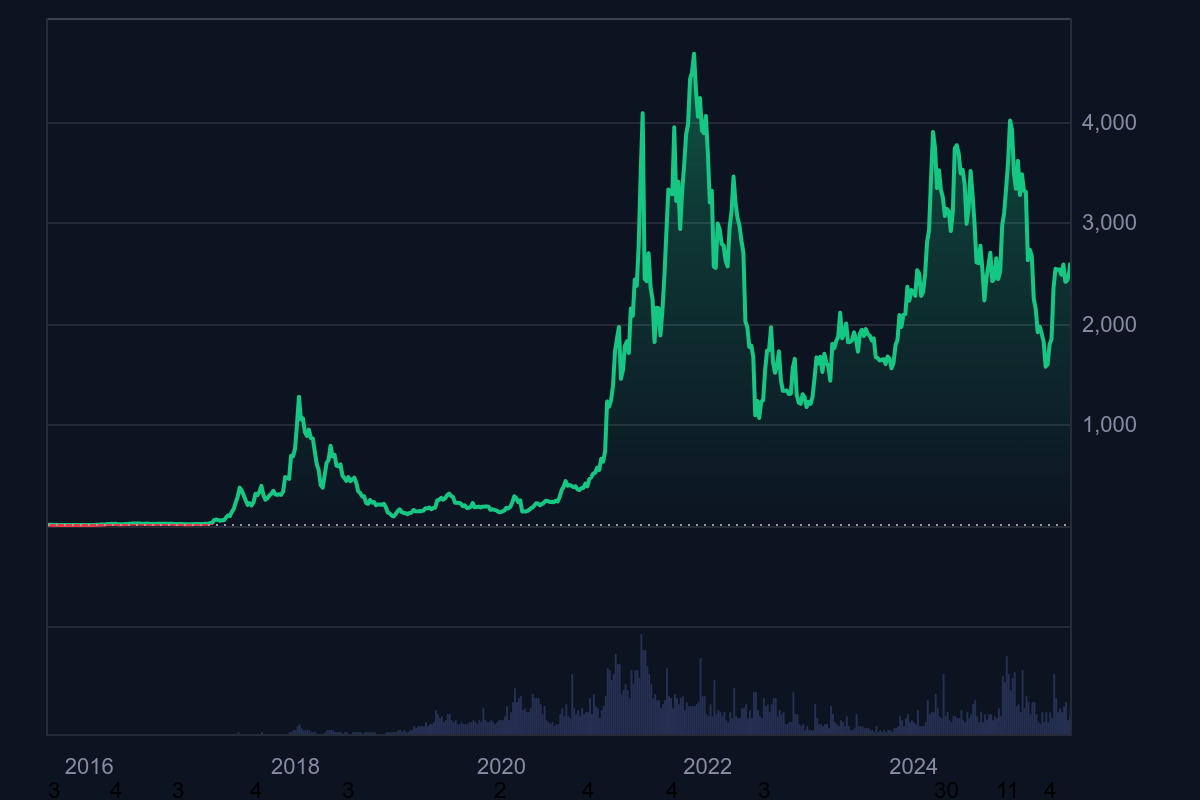
Watching the graph doesn’t really say much about what the value comes from, but it’s a start. Inspecting the graph, we are reminded about some past events:
Ethereum had a slow start compared to some modern ledgers or launch of new tokens. Usually you see a spike in the beginning. Today people are eager to be the first to invest when it’s low and sell when it’s high. Just look at TRUMP coin. Anyway, the spike in early 2018 can be contributed to the fact that dApps were starting to become popular and Ethereum at the time was making many more daily transactions than bitcoin.
in 2021-22 you can see the crypto boom followed by the FTX scandal which temporarily crashed the market.
You can see another bull run after November 9 2024 when Donald Trump won the US election, which lasted until Christmas and then came crashing down again.
Right now it’s higher than the average but considering the ongoing inflation rate, physical gold has been a more profitable long-term investment so far.
How Many Tokens are there anyway?
To make an apples-to-apples comparison with Bitcoin: An ETH token is currently worth around $2500. With 120 million in circulation, that would mean the value for one ETH token would have been $15,000 if there was only 20 million of them, like bitcoin. So the market value is still not near a Bitcoin, which is valued, at the moment, of over $100,000.
Bitcoin is fixed to a ~21 million cap. That is relatively few tokens compared to other ledgers and is one factor that drives up the price; supply and demand. What is the cap of ETH? It doesn’t have one! Ofcourse there are some technical factors that limit the inflation rate.
Not having a cap may actually be a good thing as it reduces deflation, which makes people actually use the tokens instead of just hoarding them. I personally mostly buy Ethereum because I need some for gas fees, which are quite expensive compared to other ledgers.
How ETH is created
Originally, ETH tokens were rewarded to miners when Ethereum used to be a proof-of-stake consensus ledger. The vast majority of ETH tokens were created this way, plus the initial supply of 72 million which was distributed to early project contributors and investors. At first this was a controversy as people was afraid that this would lead to a few key holders having control of the development. With time however, the distribution of ETH tokens have gradually become more diverse.
After the ETH 2.0 change, issuance of new ETH came down with 90%. New ETH can still be created through staking and good validators get rewarded with ETH.
How ETH is destroyed
Since the introduction of EIP-1559 (Ethereum Improvement Proposal) a part of the gas fee will be burned, reducing the amount of ETH in circulation.
The inflation/deflation rate varies depending on new proposals and upgrades. We can see through the years that the total supply has both gone up and down since the merge:
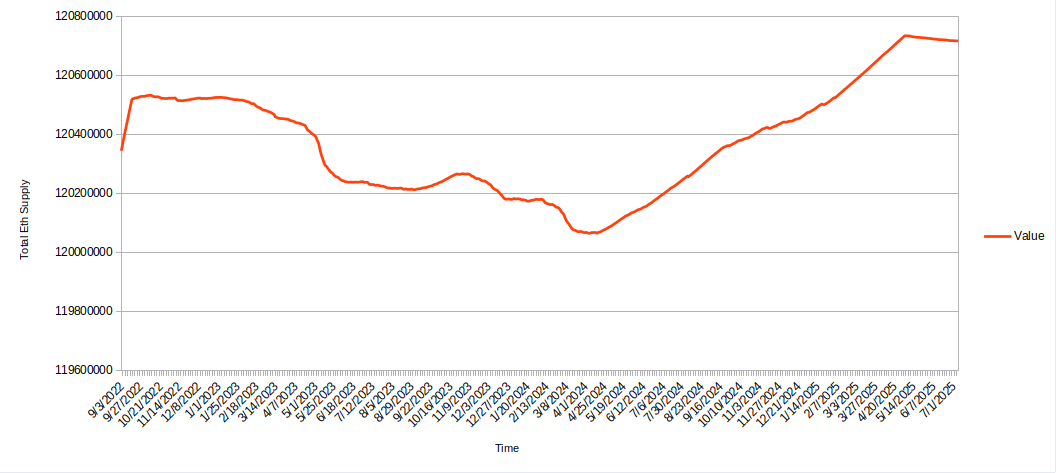
This makes it quite hard to predict what the total amount of ETH will be in 3 years ahead. That may actually be a good thing as the inflation/deflation rate could potentially be adjusted to market demands and make the price more stable. That is probably the most important thing about a medium of exchange.
Technical details about Ethereum
How Ethereum reaches consensus
Ethereums consensus algorithm migrated from a proof-of-work algorithm, like the one Bitcoin is using, to a PoS = proof-of-stake in 2022. All the problems with Proof-of-Work algorithms are already covered in Part 1 so let’s just say the main reason was to reduce energy consumption when validating transactions.
You can read about the technical details about how Proof-of-Stake works in my DLT Foundations Part 2 or read Ledgers post about it.
The Utility of Ethereum
Vitalik saw that Bitcoin was missing some of the broader eco-system that we take for granted in modern ledgers today: Bitcoin was only built for handling native token transactions. Therefore Vitalik wrote the whitepaper for Ethereum in 2013. Ethereum could, from the beginning, transport any type of information over the blockchain, which lead to development of decentralized applications and, for better or worse, stablecoins, NFTs and various shitcoins and memecoins. You could say that Bitcoin was the first generation of distributed ledgers, and Ethereum was the first Second generation ledger.
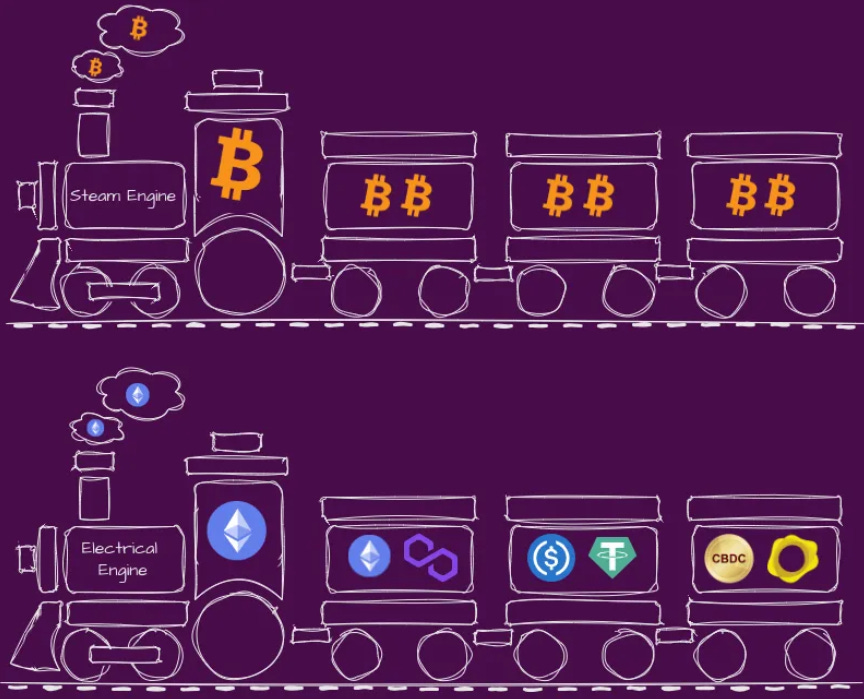
Ethereum introduced Smart Contracts, written in Solidity. It is used in many other ledgers, including Hedera Hashgraph. Many modern ledgers have developed compatibility with Ethereums Virtual Machine (EVM) so that apps developed on the ethereum can run on other ledgers as well.
Ethereum, like Bitcoin, was a huge revolution to the distributed ledger development when it first came out. It opened up a broader eco-system of not just crypto transactions, but an virtually infinite of possible use-cases for decentralized ledgers. However, It’s not always good to be the first, or the second one either. Ethereum has it’s shortcomings as well, which will be covered later.
Depending on what you are transacting, you may actually need quite alot of ETH just for gas fees. That is unfortunately not in Ethereums favor as other more modern ledgers are outperforming Ethereum in speed, energy consumption and transaction cost. That is the disadvantage of being one of the first: You are bound to the foundational infrastructure and you have to build on top of that. Meanwhile newcomers can learn from Ethereum and create ledgers with different foundation, making them potentially easier to scale.
Security
It’s hard to prove how secure the PoS algorithm actually is but it haven’t been a problem so far. One possible concern is that there seems to be no way of verifying if one party controls more than one validator. However, the millions of ETH you need to take control the network and the fact that your staked funds can get destroyed (slashed) if you misbehave, should deter anyone of trying.
Exploitation of Smart Contracts are a bigger risk and that can happen to any distributed ledger. One of the most dramatic hacks happened in 2016 when “The DAO” got hacked, which resulted in a emergency hard fork to restore users investments.
Layer 2 Sidechains
A Layer 2 sidechain is a separate blockchain infrastructure that relies on the underlying layer 1 blockchain, aka “mainnet”. Examples of sidechains are Polygon (formerly known as MATIC) and Arbitrum. These networks have their own consensus algortihms and transaction history. Transactions generally get recorded in bundles down to the ethereum mainnet, one way or the other.
I haven’t digged deeply into these sidechains but I have used the Polygon network a few times to transfer some stablecoins. I can attest that the gas fee and transaction time is significantly lower. This could be because there are much less congestion on the Polygon network.
Another consideration is that these networks may not be as secure. Since many of them didn’t go live until 2021, they are not as battle tested as the mainnet.
Sidechains help taking the load off the main network but at the moment they feel like isolated chains because you cannot seamlessly transfer tokens from one sidechain to another without having to swap tokens along the way. Vitalik wants to work more with the layer 2 technologies to make them feel more like an eco-system of networks in the future.
The Challenges of Ethereum
Vitalik Buterin is attributed to have coined the Scalability Trilemma:
The dilemma represents the difficulty of creating a decentralized ledger that is Scalable, Secure and Decentralized at the same time. When you try to improve one aspect, one of the other two have to suffer.
Where Ethereum is strong is on the security and decentralization aspects, but lacks scalability. Ethereums goal is to make it more scalable.
Hedera in comparison, which claims to have solved this dilemma with the Hashgraph, have great scalability and security, but have actually made sacrifices in decentralization. They instead work on making it more decentralized.
Note: I have written about Scalabilty challenges in my Blockchain foundations part 3.
Historically, Ethereums maximum TPS = Transaction Per Second was only about 14. That is significantly better than Bitcoin’s 7 TPS, but not much to brag about compared to Visa’s 65,000 TPS. The gas fees have always been a problem too.
The gas fees has come down significantly the last couple of years, and the TPS has increased to around 30, but is still far off from other layer 1 networks. The biggest challenges according to Ethereum themselves are:
Congested networks - The network simply can’t handle all the transactions in a timely manner and that drives up the transaction costs.
Disk Space - When the network grows, so does the hardware requirements for running a validator node.
However, the Ethereum team is actively trying to improve scalabiltiy but it takes time. Meanwhile chains like Hedera Hashgraph is running circles around them.
However, where Ethereum stands out is their dedication to their core value of decentralization. I have seen some videos and an interview with Vitalik Buterin and he seems like a visionary with the best intentions for humanity. But is that enough for Ethereum to thrive in an ever more competitive marketplace?
Ethereums decentralized infrastructure
Anyone can participate as a node operator. Leemon Baird, Inventor of the Hedera Hashgraph, choose a different route by establishing a council. The main reason for doing so is because then he knows who the validators are, even if he doesn’t trust them. He argues that it’s better than having to trust complete strangers.
However, big companies usually don’t have the common man in their best interests. Statistics shows that Ethereum nodes become more decentralized with time. Even if there is a possibiltiy that one party may control multiple validators, it should not impact the network security.
Node Requirements
One of the reasons why the Ethereum mainnet is so slow compared to other chains is that they are very careful of raising the node hardware requirements, which could potentially exclude many people from participating, making it more centralized. The hardware requirements is therefore quite manageable. For running a node Ethereum recommends:
16GB of RAM. 32GB if you plan to become a validator.
A stable Internet Connection. Speed seems not so relevant, I have read minimum 10Mbps on other pages but what is important is there cannot be any monthly data cap.
2TB of SSD Storage
Intel NUC 7th Generation* or higher
* The documentation doesn’t specify exactly what the CPU requirements are and I doubt you must use a NUC. An Intel NUC 7th Generation CPU ranges from 2.4Ghz (i3) to 3.5Ghz (i7) dual core processor.
That is peanuts compared to Hederas validator requirements.
Simply running a node doesn’t give any financial incentives but it gives other benefits. This is a summary from the “Run a Node” documentation:
Privacy - You don’t have to send your IP address together with your transaction details to a third-party validator.
Censorship Resistance - A third party could potentially block your IP. Running your own node eliminates that problem
You contribute to increased decentralization of the network, which makes the network more robust as it eliminates single points of failure
You can use your own node to look up your balance on your wallets, instead of using a third party provider.
To become a validator, you need to stake a minimum of 32 ETH. That is a challenge for most of us, unless you invested heavily in ETH back in 2016. You can get around that requirement by joining a stake pool - One example is rocket pool which is a recommended service by Ethereum. By joining a pool, you can add both your ETH and your node to the pool.
How many nodes are there, and where are they located?
There are over 10,000 active nodes distributed all over the world. Hedera have 31 (last time I checked). Not surprisingly, a big portion of those nodes resides in USA but also Germany and UK. According to Cointelegraph: over 50% of all the nodes are running in AWS = Amazon Web Services:
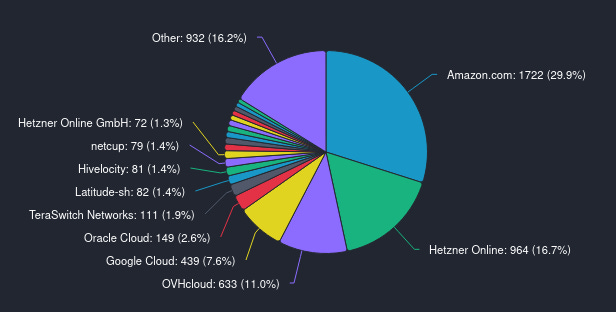
However that is not accurate. Yes, over 50% of all the cloud hosted nodes were on Amazon but as we can see the numbers have shifted significantly since 2022. Also, only 50% of all the nodes are cloud hosted:
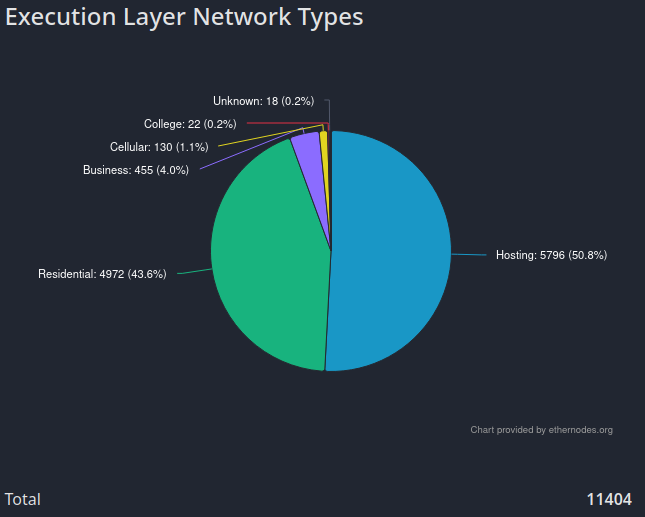
That brings the total number of nodes on AWS down to around 15%.
Note: I don’t know fore sure what’s the difference between Execution Network Types and Consensus Network Types but what I get from reading on the Internet, I believe it counts all the nodes, validators or not, that are participating in the Ethereum network. You can do your own research if you are not convinced.
What I can conclude from these statistics is that it seems the Ethereum network gets more and more decentralized over time.
Future of Ethereum
As mentioned in the challenges of Ethereum, scalability needs to increase significantly to be competetive in the long run. Ethereum has a roadmap where the end goal is to reach a 100,000 transactions per second. It may however be a few years until they reach that goal.
The Surge
The codename for the complete project is called the Surge but it is divided into smaller parts. Dencun was rolled out last year, Pectra was just finished and Fusaka is in the near future. I’m not going to bore you with technical details about what every upgrade does. You can look that up for yourself in Ethereums documentation.
I will however address some notable upcoming changes on how Ethereum are going to technically make the network more scalable, while at the same time balance security and decentralization.
Danksharding
Earlier plans suggested that traditional sharding was going to be implemented, but that seems to have been scrapped in favor of an emerging technology they call Danksharding. This technology will potentially make Ethereum able to have comparable TPS with other modern ledgers. It does so by leveraging layer 2 blockchains that process multiple transactions off-chain, put them into “blobs” and compresses them to reduce the datastorage required.
To understand what danksharding is, you have to read up on it’s underlying components
Layer 2 Rollups
Rollups are a layer 2 blockchain technology. Layer 2 is a collective term for scaling solutions that handle transactions off the layer 1 blockchain. The other two available alternatives are plasma chains and side chains.
Rollups bundle (or 'roll up') hundreds of transactions into a single transaction on layer 1 (the mainnet). This distributes the L1 transaction fees across everyone in the rollup, making it cheaper for each user.
Proto-danksharding
Proto-danksharding is the first step of implementing full danksharding. It was introduced in the Dencun upgrade 13th March 2024. It introduces a new data type called “blobs”. They are meant to increase the efficency of Layer 2 Rollups.
Ethereum used to store all transactions on each node in the network, which lasted indefinitely. Blobs have an expiration date of 4096 epochs, roughly 18 days. Blobs are the output of the bundled (rolled up) transactions. The blobs are committed to the L1 chain with a mathematical algorithm called KZG.
KZG commitment
KZG compresses the rolled up blobs into a cryptographic commitments that is put on the L1 chain. Verification is based on zero-knowledge techniques, basically proving that the transactions have been verified without actually showing the proof (It’s very complex math). It is designed to reduce the data stored on the blockchain.
Timeline for Danksharding
These are all bleeding edge technologies that only existed on paper 5 years ago. A full danksharding upgrade may be several years in the future due to continued developing and meticulous testing required.
Closing thoughts
The more I read about Ethereum, the more positive I become (it’s the opposite with bitcoin). It seems to be a strong community behind it and they are dedicated to not compromise on security or decentralization to achieve scalability.
Technical standpoint
Right now they are behind other prominent ledgers when it comes to scalabilty but I respect the community efforts and I want them to succeed with their goals.
What I am concerned about is that dApp developers may look elsewhere if Ethereum doesn’t scale rapidly. Ethereum needs to increase their TPS significantly NOW, not in a couple of years. However, Ethereum doesn’t need to be as scalable as for exampe Hedera, it only needs to be fast enough.
I believe the main reason why it’s so complicated to scale Ethereum is due to technical debt. They are bound to their foundation. The Ethereum community is not backing down from a challenge though: They managed to change the consensus algortihm from PoW to PoS without a hiccup, a feat worth bragging about.
Economic standpoint
The ETH token has some intrinsic value compared to Bitcoin, as it is needed for transporting other token and dApp data across the network. ETH may not be the perfect decentralized medium of exchange due to high fluctuation in value but the network could possibly be transporting it.
The ETH token is probably overvalued because the market is still driven by speculation and not focusing on utility. That might change in a few years time.
Conclusion
Even though it might not be the perfect decentralized ledger, I believe the chance of Ethereum becoming corrupt is far lower than on other ledgers. If all else fails, this could be a valid option. I endorse it, even if it might not be my favorite.




